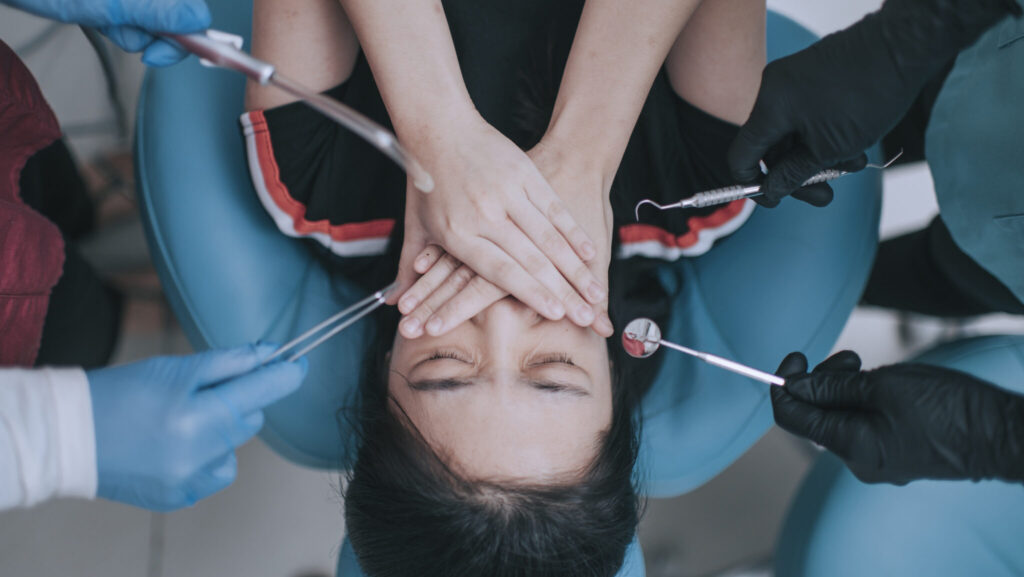
We’re entering a bold new era of healthcare—one shaped by personalized medicine, preventative care, and a more integrative understanding of the body and mind. And at the heart of this evolution is something long overlooked: oral health.
Once seen as separate from the rest of the body, it’s now recognized as a cornerstone of lifelong wellness—and a powerful lens into the emotional and psychological dimensions of care.
The research is clear: oral health is not an isolated concern—it’s intricately connected to the health of the entire body. As the gateway to both the digestive and respiratory systems, the mouth plays a central role in systemic function. The oral microbiome—a complex ecosystem of bacteria, fungi, and viruses—extends its impact far beyond the teeth and gums, playing a key role in immune function, systemic health, and the body’s inflammatory responses. Disruptions in this delicate balance have been linked to an increase in chronic disease, stroke, heart disease, diabetes, and osteoporosis, as well as a growing body of evidence linking it to increased susceptibility to certain cancers. Alzheimer’s disease has been shown to progress more rapidly in the presence of certain oral pathogens. Additionally, oral dysbiosis has been associated with autoimmune disorders, leaky gut, infertility, and even erectile dysfunction has been traced back to the impact of oral inflammation. Far beyond a smile, the mouth is a mirror—and often a messenger—for the health of the whole body.
Read related article: Online dental misinformation induces fear in Gen Z and millennials
With all this information, you’d think people would be rushing to go to the dentist to optimize their oral health. But in reality, that’s not what’s happening. So why is that?
The silent crisis: DFA—What is it and what it means for us?
Despite modern advances in anesthesia and comfort-focused dentistry, many people continue to avoid the dental chair. The reason? Dental Fear and Anxiety (DFA)—a condition that affects a significant part of the population.
As a dentist, I know all too well that my office isn’t everyone’s favorite place to be—though there are a few exceptions! Dental visits can be stressful, sometimes uncomfortable, and often expensive. Still, in just one appointment, we can relieve pain, restore function, and send patients on their healing way. It’s a complicated relationship—patients know they need us, even if they’d rather avoid us.
I don’t take it personally when a patient ducks behind an aisle at the grocery store or avoids eye contact on the street. As much as I’d love to think of myself as warm and approachable, I understand the anxiety that dentistry stirs up. Dentists live in this strange paradox: we’re both needed and feared. We’re the healers no one wants to see—and yet, when people finally do walk through our doors, we often become the ones who bring the most relief.
We are currently seeing a high prevalence of dental anxiety across diverse populations. This high prevalence of dental anxiety suggests it may be an underrecognized crisis in healthcare.
Globally, about 15.3% of adults experience DFA, with 12.4% reporting high levels and 3.3% suffering from severe cases (Armfield, 2021). In the U.S., 36% of adults admit to some fear of dental treatment, and 12% experience extreme fear (Cleveland Clinic, 2023). A recent survey revealed that 24% of Americans skip dental visits due to anxiety—especially men, who report higher rates than women.
This fear leads to avoidance, and that avoidance worsens oral health. It creates a vicious cycle that ultimately diminishes a person’s health and quality of life.
Why is dental anxiety so common? The answer lies in a mix of psychological, cultural, and sensory factors. Patients often describe the experience of being reclined, mouth open, unable to move or speak, as deeply unsettling. Sounds of drills, the smell of antiseptic, and childhood memories of painful procedures all add to the fear. Unlike elective pain (tattoos, laser treatments etc.), dental procedures are often viewed as obligatory and invasive—making the discomfort feel unjustified.
In a 2025 survey, 57% of people admitted to lying to their dentist about their oral hygiene. Guilt followed for 64%, yet nearly 53% still don’t floss regularly, and 68% brush for less than two minutes. Dental fear doesn’t just affect behavior—it reshapes our relationship with oral health.
Dental fear and anxiety (DFA) often have deep roots, and according to Kaur et al. (2015), these fears typically emerge through five key pathways. The most common is direct conditioning—where a person has experienced a painful or traumatic dental visit firsthand. And let’s be honest: teeth can hurt. Infections can build pressure that becomes excruciating. Sometimes the anesthetic doesn’t work as expected, and patients feel pain despite our best efforts. Needles, a necessary part of care, can trigger intense fear—especially for those with needle phobias.
Others develop fear through vicarious learning, witnessing someone else suffer. Informational sources—like horror stories from friends or sensationalized media portrayals—can magnify anxiety before a patient ever sits in the chair. For some, dental visits were introduced through verbal threats in childhood, creating deep-rooted associations between punishment and dentistry. And often, fear is passed down through parental modeling, where children absorb the unease of anxious caregivers.
If we want to make lasting change in how patients experience dentistry, we have to go deeper than just managing symptoms—we have to get to the root cause. And often, the root isn’t in the patient alone—it’s in us, the providers and the practitioners. Helping someone feel safe in the dental chair requires more than technical skill; it asks us to bring empathy, presence, and emotional clarity into the room. We must be able to recognize what our patients carry—whether it’s fear, trauma, or distrust—but we can’t do that if we’re disconnected from our own internal world. If we haven’t taken the time to process our own stress, regulate our nervous systems, or acknowledge the emotional weight we bring into the operatory, we limit our ability to truly show up for others. We can only meet our patients as deeply as we’ve met ourselves. That’s the real work—and it’s where true healing begins.
The forgotten chair: The other face of dental anxiety
The dental profession is one of the most demanding in healthcare. As practitioners, we often focus on our patients’ dental anxiety—but rarely do we talk about our own. What about the stress, pressure, and anxiety we carry as dental clinicians?
Many dentists wear two hats—one as a clinician and the other as a business owner. The pressure to excel in both roles, often without formal training in business or practice management, can take a significant toll on our nervous systems. It’s a weight that can leave us feeling isolated, overwhelmed, and stretched beyond capacity.
As a dentist and business owner, I’m deeply familiar with the pressures of this profession. As an internationally trained dentist, I had to undergo one of the most rigorous recertification processes in the field—an exam known for its exceptionally low pass rate. It tested my resilience from the very beginning. To make things more challenging, I faced a College complaint very early in my career, filed by a fellow colleague—an experience that felt like being thrown under the bus at a time when I was just finding my footing.
During my career, I navigated the loss of key team members, uncovered serious internal challenges within my practice, and endured a global pandemic and devastating flood caused by an atmospheric river. Through it all, I remained committed to refining my clinical skills through continuing education, studying oral surgery and functional medicine to better serve my patients.
The added stress didn’t just stay in my environment—it began to show up in my body. Not long after purchasing my practice, I was diagnosed with thyroiditis and Hashimoto’s autoimmune disease. The emotional and physical toll of carrying so much for so long had finally caught up with me.
The long-standing idea that dentists have the highest suicide rate highlights the significant stress associated with the profession. Dentists face chronic stressors from physical strain, especially in the neck and back area, emotional labor, and constant performance pressure. We juggle clinical precision, tight schedules, complex procedures, and anxious patients—all while running businesses, managing staff, and often doing it alone. I’ve heard countless stories from colleagues—dentists breaking down in the operatory, tossing instruments in frustration, lashing out at assistants. It’s completely unacceptable—but it’s also a cry for help.
Verbal abuse, emotional misconduct, and toxic dynamics don’t emerge in a vacuum. They’re symptoms of a system that is breaking its own caregivers.
Burnout is common in our profession. So is emotional exhaustion.
Studies have shown that 83.4% of dental professionals experience occupational stress (SAGE Journals, 2021), particularly women in private practice. The burden is real—and if we ignore it, it seeps into every corner of the clinic.
If we want to create safe and welcoming spaces for our patients, we must first recognize who sets the tone—and that’s us, the practitioners.
Heal the dentist, change the experience
Before we can build trust with our patients, we must first cultivate it within ourselves. It’s a daily practice—to gather ourselves, each morning before we step into the office, see our first patient, or greet our first team member. Taking just a few moments to pause and center ourselves helps us reconnect with our purpose: to listen, to care, and to serve with intention.
We must be able to set aside our own stresses, opinions, and assumptions to be fully present with those we serve. Every person in the chair brings their own fears, stories, and needs—and we can’t meet them with clarity or compassion if we’re clouded by our own internal noise. It’s not just about clinical skill; it’s about emotional presence.
By gathering ourselves at the start of the day, we enter the room grounded and present—able to convey a sense of safety without saying a word. Our presence sets the tone. It signals to patients that they’re not just being treated—they’re being cared for. And that’s where true healing begins.
Tools to use
Let’s start with the breath—one of the fastest and most accessible ways to calm the nervous system in real time. As neuroscientist Dr. Andrew Huberman explains, specific breathing patterns like the psychological sigh or box breathing, can directly shift us out of a stress state and into calm within moments. No equipment, no prep—just the body’s own built-in reset button.
While putting myself through dental school, I taught a lot of yoga and I learned how breath, and presence could create a sense of safety. The tools I gained first helped me manage my own anxiety and stay steady in stressful situations. From that calm place, I can better support my patients. I often breathe with them, use body scans, and gently guide them out of anxiety and back into their bodies. The calm I offer them begins with the calm I’ve learned to create within myself.
Beyond breathwork and body awareness, there are other powerful tools that can help ease dental anxiety. Listening is one of the most powerful tools we have as clinicians. It means truly hearing our patients—without interrupting, without rushing to form a diagnosis. It means letting them finish their thoughts, leaving space before we respond, and allowing them time to add more if they need to. When patients feel genuinely heard and understood, fear begins to soften, and trust starts to build.
Laughter, even in small moments, can be incredibly therapeutic, shifting the nervous system from a state of fear to one of connection. Incorporating gentle humor, a relaxed tone, or even soft music in the background can ease tension and create a more welcoming environment.
There are many other tools that can support patients in managing dental anxiety and building trust. Approaches like EMDR (Eye Movement Desensitization and Reprocessing), somatic therapy, and trauma-informed language can make a profound difference. Even simple shifts—like the words we choose, the pace we move at, or the tone we use—can help rewire the nervous system’s response to care. Every small act of awareness becomes part of a larger healing experience.
The way forward: Re-telling the story
The path ahead requires more than clinical excellence — it calls for intention, support, and a shift in how we care for ourselves as caregivers.
It starts by recognizing that we cannot pour from an empty cup. Moving forward means prioritizing practical tools, support systems, and a sense of community within the profession. It means acknowledging the emotional labor of holding space for others and integrating mindfulness, mental health resources, and reflective practices into our daily routines.
Once the dentist begins their own healing, a profound shift becomes possible—one that redefines the dental experience itself. No longer rooted in fear, shame, or hierarchy, the dental office can evolve into a space of mutual safety, trust, and compassion. Fear gives way to calm. Shame transforms into trust. Patients feel heard. Staff feel respected. Everyone breathes easier.
This is a new era of care—where the dental chair becomes a place of transformation. Dentistry is now about prevention, optimization, and empowerment. Patients don’t have to wait for tooth pain to see their dentist. They can go because they want to be healthy, feel better, and live longer.
This is more than treating teeth. It’s about rewriting the dental experience—creating a safe space where people want to go, not because they have to, but because it’s where healing begins.
References
- Armfield, J. M. (2021). Dental fear and anxiety: Prevalence and associated factors in adults. International Dental Journal, 71(1), 22–29. https://pubmed.ncbi.nlm.nih.gov/33711405/
- Kaur, R., Vinnakota, D., Panat, S. R., & Aggarwal, A. (2015). Assessment of prevalence of dental anxiety in children aged 3 to 14 years attending dental OPD in North India. Journal of Clinical and Diagnostic Research, 9(11), ZC06-ZC09. https://www.ncbi.nlm.nih.gov/pmc/articles/PMC4233415
- Al-Omari, W. M., & Al-Omiri, M. K. (2022). Dental anxiety and its association with psychological status and oral health-related quality of life. International Journal of Environmental Research and Public Health, 19(4), 2380. https://www.mdpi.com/1660-4601/19/4/2380
- Taani, D., et al. (2020). Evaluating factors associated with fear and anxiety to dental treatment. Journal of Family Medicine and Primary Care, 9(9), 4562–4567. https://journals.lww.com/jfmpc/fulltext/2020/09090/evaluating_factors_associated_with_fear_and .7.aspx
- Cleveland Clinic. (2023). Dentophobia (Fear of Dentists). https://my.clevelandclinic.org/health/diseases/22594-dentophobia-fear-of-dentists
- New York Post. (2025). Nearly half of Americans believe dentists can see through lies about oral hygiene: Survey. https://nypost.com/2025/03/11/lifestyle/nearly-half-of-americans-believe-dentists-can-see-throug h-lies/
- SAGE Journals. (2021). Analysis of Occupational Stress, Burnout, and Job Satisfaction among Dental Practitioners in the Private Sector. Work, 68(4), 1057–1066. https://journals.sagepub.com/doi/full/10.3233/WOR-210555
- Wiley Online Library. (2021). Sources of Occupational Stress Amongst Dentistry Academics. *
About the author

Dr. Lila Popa is a dentist and certified functional medicine practitioner based in Vancouver, Canada. With an interest in functional dentistry she focuses on the connection between oral health, systemic health, and overall well-being. Dr. Popa integrates evidence-based care with a trauma-informed, compassionate approach to help patients feel safe and empowered in the dental chair. Dr. Popa’s mission is to transform the dental experience into one rooted in trust, healing, and holistic care.











